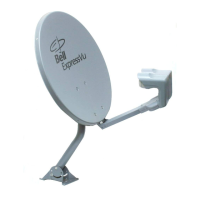Page I-20
Installation Guide
1. Take a compass and the direction and elevation numbers
to your planned location for the satellite antenna.
(VERY IMPORTANT)
Make sure the compass is well away from metal objects, and
that there are no magnetic or electronic devices nearby.
Holding the compass so the needle can swing freely, turn the
compass until the dark end of the compass needle is aligned
on the N. This points to magnetic North. The compass face
is divided into 360 degrees, North is zero degrees (0˚), East
is 90˚, South is 180˚, and West is 270˚.
2. On the compass, find the direction number provided by the
Satellite Location Reference Chart. Turn to face this
number, while keeping the dark end of the needle over the
N. This is the direction of the satellite. Find a landmark,
or lay a stick or board on the ground lined up in that
direction.
3. Use the elevation number from the chart to find out
how high the satellite is in the sky from your location.
You know that vertical is 90˚, and horizontal 0˚, and
halfway in between is 45˚.
Stand close to where you plan to mount the satellite
antenna and face in the direction that you marked for
the direction to the satellite. Using the elevation angle,
find the closest approximation to that angle in the sky.
You now are pointing to the approximate location of
the satellite.
4. Note whether there are any obstructions between you and
the satellite. Leave a margin for adjustment, because
you have not yet aimed the antenna exactly.
If there are obstructions, you will have to find a new
location, or remove the obstruction, if possible.
5. If necessary, repeat steps 1 through 4 until you
have located the best location for the antenna.
The best location should provide a sturdy support
for the antenna, plus it must have a clear line of
sight. Mark the spot and the direction to the satellite.

